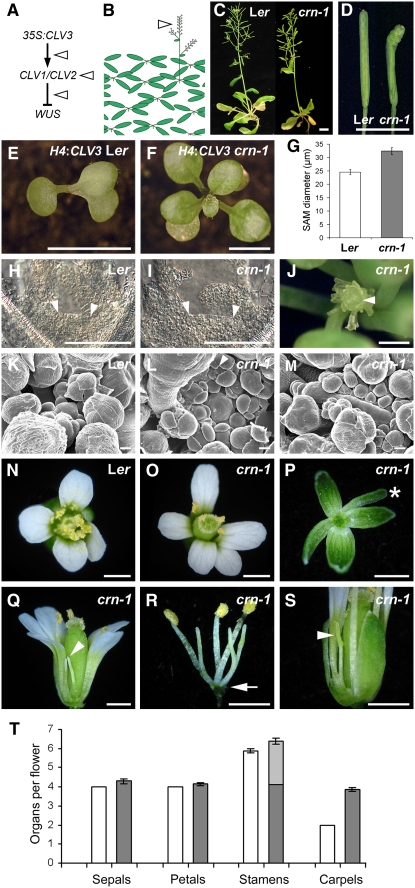Figure 1.
Phenotype of crn-1 Mutants.
(A) Concept of the mutant screen. The arrowheads indicate the possible positions of suppressors in the CLV3 signaling pathway.
(B) Cartoon illustrating that suppressor mutants form inflorescence shoots with flowers.
(C) Wild-type (Ler) and crn-1 plants, 5 weeks after germination.
(D) crn-1 siliques are club-shaped and carry more carpels than wild-type siliques.
(E) and (F) An H4:CLV3 transgene arrests SAM development in wild-type (E) but not in crn-1 (F) seedlings.
(G) to (I) Increased meristem size in crn-1. SAM diameter was measured across the surface (arrowheads in [H] and [I]) (n = 40; ±se).
(J) crn-1 inflorescence at 29°C. The enlarged SAM arrests (arrowhead) with the formation of carpelloid organs.
(K) to (M) Wild-type (K) and crn-1 ([L] and [M]) meristems at 22°C. The arrowhead in (L) indicates the extra sepal. In (M), the inflorescence meristem is strongly fasciated.
(N) Wild-type flower, with four petals and six stamens.
(O) to (S) crn-1 flowers grown under continuous light.
(O) and (P) The gynoecium is enlarged, and some flowers carry five petals or additional sepals (asterisk in [P]).
(Q) Lateral view of the same flower shown in (O). Two stamens are shorter and lack anthers (arrowhead).
(R) Third whorl organs; three stamens lack anthers. The arrow indicates the flower basis.
(S) crn-1 stamens may remain immature (arrowhead).
In (P) to (S), organs or complete whorls were removed.
(T) Organ number in crn-1 mutant flowers (gray bars; n = 20) compared with wild-type flowers (white bars; n = 10) grown under continuous light. The light gray bars indicate the number of stamens lacking anthers. se is indicated.
Bars = 10 mm in (C), (E), and (F), 1 mm in (D), (J), and (N) to (S), and 50 μm in (H), (I), and (K) to (M).

